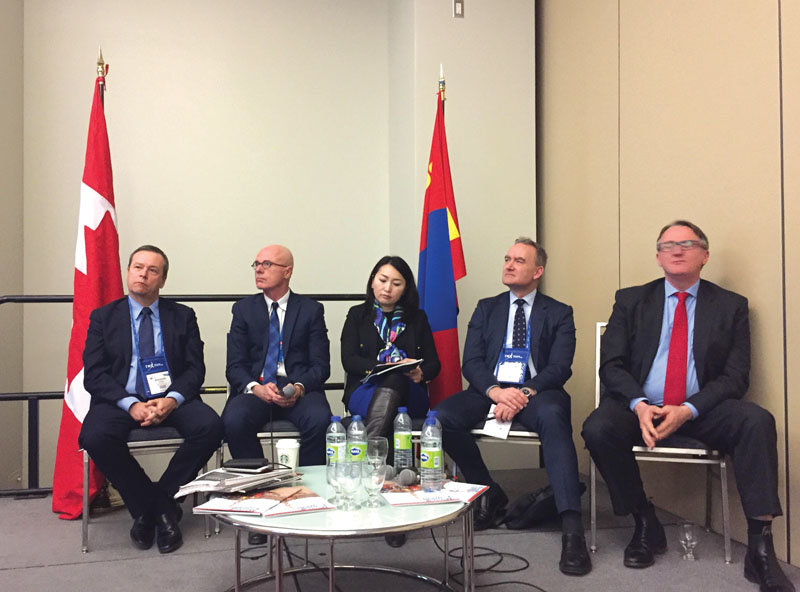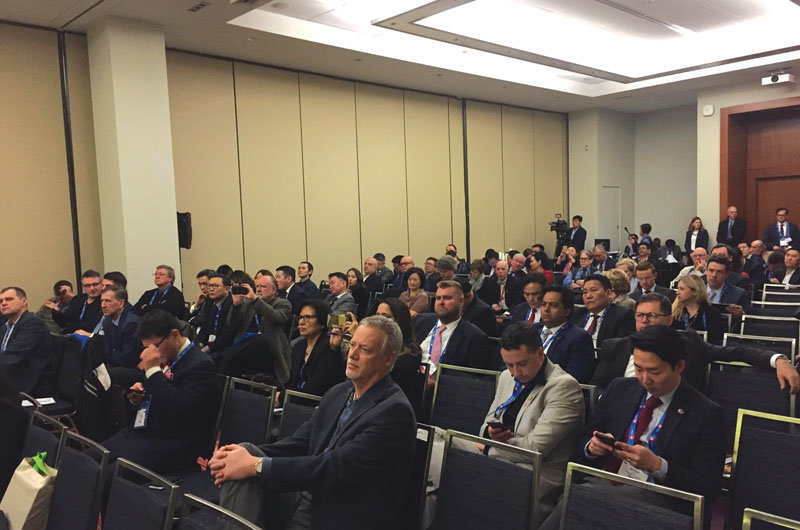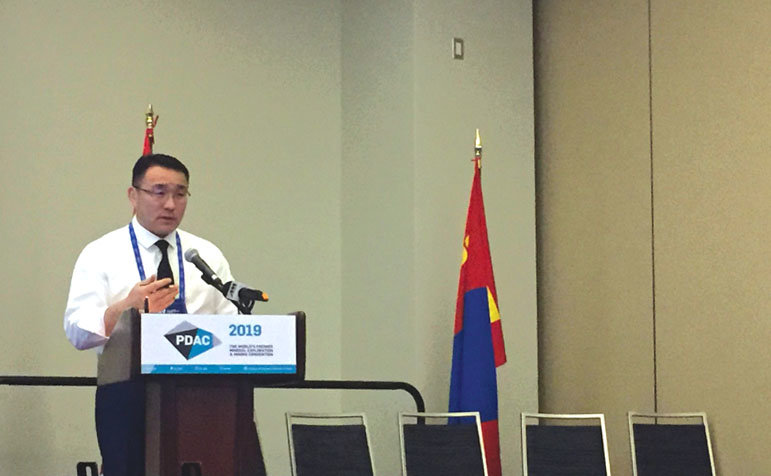
The Mongolian Mining Journal, March.2019
B. Aligermaa
It was heartening to see at the latest PDAC (The Prospectors and Developers Association of Canada) convention how Mongolia commanded the attention of many of the 25,843 attendees from more than 130 countries at the world’s premier annual mineral exploration and mining event, held in Toronto from March 3 to 6. This clear expression of international interest in the event led the PDAC President, Glenn Mullan, to aver that even in the face of “economic challenges and uncertainty, the mineral exploration and mining industry is experiencing a renaissance and renewed sense of confidence, highlighting its resilience once more.”
To come back to Mongolia, our Minister of Mining and Heavy Industry, D. Sumiyabazar, was among the ministers responsible for mining in 24 countries from around the world who took part in the 4th International Mines Ministers Summit (IMMS) on March 5, organized by PDAC jointly with the World Economic Forum, to explore the future of responsible mineral supply chains.
This year Mongolia had its largest ever pavilion at the PDAC, enabling a large attendance at the well-planned Mongolia @PDAC 2019 event on March 4. The Mongolian team there, representing both the public and private sectors, included Minister Sumiyabazar, the CEO of Erdenes Mongol, senior executives from Oyu Tolgoi LLC, Steppe Gold, Xanadu Mines, and Erdene Resource Development, and a big international audience, including the Director for Natural Resources at EBRD, investors, financial advisors, technical experts, and lawyers.
The sessions covered three themes: an overview of mega projects, exploration and development opportunities and practices, and investment environment competitiveness. In his opening remarks, Sumiyabazar highlighted the government policy initiatives in 2019, which include developing a separate detailed policy and strategy for each major mineral, including gold, copper, rare earth elements, battery minerals, coal and uranium. Another would be issuing licences for mid-sized short-term projects. An example of this would be the Altan Tsagaan Ovoo project, as explained by Steppe Gold’s Vice President and Director, B. Tumur-Ochir, in his presentation.
The Erdenes Mongol presentation highlighted the proposed development of Shivee Energy Export Complex, the Asgat silver deposit, and Erdenes Methane, the last to be based at Tavan Tolgoi. The company CEO, Gankhuu Purevjav, hoped that the proposed Sovereign Wealth Fund “might be the solution to the social challenges we face” and become a tool to share the nation’s wealth in “an equitable and inclusive way”. Referring to changes in his own company, he said planned reforms would “ensure sound governance, prudent risk management, and efficient administration”.
In her remarks, Undraa Agvaanluvsan, Member of Parliament and Chair of the Parliamentary Committee on Responsible Mining, said work-related safety was the most important issue for Mongolians. She urged all Mongolian mining companies to “improve the safety practices in their daily operations”, and commended Oyu Tolgoi for bringing the best safety practices to Mongolia.
Bulgantuya Khurelbaatar, Deputy Minister of Finance, provided informative answers to questions from investors and prospectors, ably fielding some uncomfortable ones. For example, replying to a question on raising the licence transfer tax to 30% of the sale price, she readily admitted that “there was a backlash from the mining sector, especially from prospectors” and said that, subject to Parliament’s approval of a new tax reform policy, the tax would be 10%, “with more stringent enforcement of compliance”.
Addressing concerns about the lack of stakeholder consultation prior to any important changes made by Parliament, Bulgantuya explained how the Investment Protection Council now deals with complaints received from investors and keeps the Cabinet Secretariat informed of its responses. The government has also signed a transparency agreement which mandates public debates on issues directly affecting investment. Besides, any draft law and amendment can be discussed in Parliament only after 45 days of being presented for public debate.
Taking part in a panel discussion, the Deputy Minister said: “The biggest criticism we receive is related to the short-medium term stability. During the last boom-and-bust cycle, our economic growth rate fell from 17.3% to 1.2%. This has convinced us that rather than looking at short-term gains, we have to take a longer-term view, putting in place a more stable investment environment in place.”
Explaining how it works, she noted that in the last few years, “we have not made any changes in the tax regime, except increasing the licence transfer tax”. She also revealed that the proposed new tax law is more about “introducing global standards” than increasing taxes.
The consensus among speakers at the event was that Mongolia is doing well in adopting modern mining practices, whether in safety, environmental rehabilitation, or tax issues. The boldest statement came from Eric Rasmussen, Director for Natural Resources at EBRD, “The learning process over the past 15 years is now resulting in encouraging investors to look forward.”
We shall certainly hear more about what Mongolia has learnt when such interactions are held at the next PDAC convention, scheduled for March 1-4, 2020.

The Canada touch
David Sproule, the Canadian Ambassador to Mongolia, made some interesting observations, first when he welcomed participants to Mongolia @PDAC 2019, and, then, at a panel discussion. Some excerpts are given below.
“The year 2018 saw Canada and Mongolia celebrate the 45th anniversary of their diplomatic relations and the 10th anniversary of the establishment of our Embassy in Ulaanbaatar.”
“Canada is Mongolia’s leading foreign investor in the mining sector, with more than 90 percent of Canada’s CA$6.7 billion investment in Mongolia being in the mining sector.”
“We are doing some important work in the area of technical cooperation. Many Mongolian and Canadian institutions are working in partnership to help Mongolia develop a consistent regulatory framework and management expertise in the extractive industry. As in any meaningful relationship, we have also had our differences, such as on the issue of corporate income tax amendments, ongoing sale of mining licences and on the parliamentary working group examining the merits of the Oyu Tolgoi project, including its investment agreement. But as good partners do, we have learned to be open and honest with all these and address them when they arise. Special thanks to the Minister, who has been very receptive to our concerns and has proved to be a reliable partner of Canada and the international mining community, and an active advocate for investors.”
“There has been significant progress in the overall economy of Mongolia in the past two years. With fiscal discipline in place, it is also important to focus on the investment climate. In order to really pursue prudent investment plans, it is necessary to have early discussions with stakeholders. Some of the moves that alarmed the investment community also came to it as a surprise. For example, in the case of the corporate income tax changes in the 2018 budget, it was imposed without consultation.”
“Given its geology, the foreign investment community in Mongolia can work there with the rules that are in place in the most part, but only if they are applied consistently and over a significant period of time. Constant changes and unexpected application will undermine its confidence.”
“You could underestimate how competitive the mining boom is and how companies that would like to come and invest also have alternative destinations. As good as the geology is in Mongolia, if investors don't believe the regulatory and oversight infrastructure is reliable and predictable, they will go elsewhere, maybe come to Canada. The Government just has to make sure it gets things right and doesn't destroy what could be a very good thing over the long term to save the country economically.”

Tender law needs immediate changes: D. Sumiyabazar
It has been a prosperous year for mining internationally, and Mongolia is no exception. With a return of investor confidence, there has been new and increasing foreign investment in our geological exploration sector. We must take advantage of the present favourable market conditions, to push forward several planned steps.
The Tavan Tolgoi IPO has raised expectations in the international market. More and more foreign investors are showing their interest. Our preparations are going well.
Some changes have to be made to the Law on Procurement of Goods, Works and Services with State and Local Funds, known commonly as the law on tenders. Provisions in the current law could force us to choose unqualified and infamous bidding companies, which risk being black-listed in a large stock exchange. We cannot do that with Tavan Tolgoi. Therefore, we need to wait for some time and amend the law to put in options that would make Erdenes Tavan Tolgoi a company run on international standards. Only this would allow Mongolians to receive the most benefit, boost economic and social growth, increase wages, pensions and other benefits, and create new jobs.
Regulatory and preparatory work on the IPO should be done upfront, all the more as this is a strategic deposit and involves national security. Draft changes to the law on tenders will be submitted to Parliament under high priority as the issue must resolved as early as possible, for the good of Mongolia, Mongolians, and its economy.
Incidentally, in case there is delay in raising capital from the IPO, we are studying other options on how to move forward the big infrastructure projects. These can be operated under concessional agreements or as public-private partnerships. If these are successful, the IPO proceeds can be utilized on export-driven mining projects.
(This is the gist of an informal one-to-one conversation B.Aligermaa had with the Minister of Mining and Heavy Industry at the PDAC convention.)
On the sidelines of PDAC 2019
The 87th annual PDAC Convention,held in Toronto from March 3 to 6, lived up to its name as the most-attended event for the world's mineral exploration and mining sector, with over 25,000 delegates from more than 130 countries, including Mongolia,attending. MMJ Editor B.Aligermaa had brief and informal conversations with some of them.
Armando Torres, CEO of Oyu Tolgoi LLC
“Work on the power plant is going on in three areas”
When is the preliminary feasibility study for the power plant likely to be completed?
We are working in three major areas. First, we are doing due diligence to ensure that legally we are OK. The second is the environmental and social impact study. And the third is the commercial and the financial arrangements. Work on these is going on simultaneously. We expect to have the results by October and these will then be submitted to the OT board and stakeholders. Once their approval is received, we shall finalise the financial and commercial arrangements and our plan is to start the construction in March 2020.
Should the final approval from the government be a problem?
We are working with the Ministry of Energy all the time, keeping it in the loop along with our board of directors. The government of Mongolia is a key stakeholder, so by October we shall know its views.
Will there be a renewable energy option in your study?
Look, the first priority is the coal power station, because that will have the proven technology to operate in the underground mine, but of course using renewable energy is part of our overall plan.
But, it will not be included in the preliminary study, right?
No, it's a separate study.
Jeremy South, Chief Financial Officer, Steppe Gold
“We have shown you can develop a project quickly in Mongolia”
Will you start extraction at the AltanTsagaanOvoo gold project in Dornod aimag this year?
Once construction of the ADR (absorption, desorption and refining)plant building is finished -- and we are doing good progress -- we can apply for the cyanide permit and then start to leach ore.
What is the timeline?
We should start in the next few months or through the summer months. We are saying summer at this point.
What is your position on the gold royalty rate?
We would obviously like it to be brought back to two and a half percent. That is our clear preference.
AltanTsagaanOvoo is your primary focus now, but what about your other projects?
Well we have another certain project in the Bayankhongor area, a large land package that we're looking at. We've been hoping to drill and trench this year and did some exploration work last year, some sampling. And we also plan to be looking at other assets in the country -- other heap leach projects, other potential precious metal projects where we think we can add value, and where our team can be a good fit.
How are you cooperating with the local communities?
We got them involved very early in the project and a number of our employees have been living in the area. This approach has really helped in building a partnership with the local community.
Anything else you would like to tell our readers?
It's good for people to understand from what we have done that you can develop projects quickly in Mongolia, which I think is very positive.
Peter Akerley, CEO and Director of Erdene Resource Development
“The Khundii Gold Project PEA has created value for our shareholders”
How happy are you with the results of the Khundii Gold Project Preliminary Economic Assessment?
Well, what we wanted to demonstrate is that the high grade we've seen at the Khundii project would carry through to a strong economic model. And we've seen that now with very high return on investment. Strong net present value. So, we're very pleased with the results.
Why have the estimated reserves at Altan Nar and Bayan Khundii come down?
The figures that came out in September were 45 tonnes, about a gram gold equivalent. What we wanted to demonstrate in the PEA is that we could have a very robust economic startup. So, initially we'll be working with about, I think, 500,000 ounces, a three point four grams, so about a third of that resource. But, ultimately we'll be using up more of that resource as we go through the pre-feasibility and into development. But the focus was on a simple easy open pit development. So, we're just using a portion of those total resources.
ERD share prices have been falling after your cross listing on the Mongolian Stock Exchange. Why is this so?
I think mining shares are generally going down in the global market, and this is just part of that trend. But you also have to look at the PEA to see what we've done to create value for our shareholders. The PEA value is $99 million and our current market capitalization is $30 million. So, there's tremendous room for appreciation. I think we're just caught in a market cycle and we continue to put our heads down and create value.
Andrew Stewart, Managing Director and CEO of Xanadu Mines
“Our focus now is on the higher grade discovered”
You have been very enthusiastic about the bornite mineralisation intersection in the Kharmagtai copper project area. Will this lead to an increase in the resource estimate?
Our focus now is on the grade. The bornite mineralisation demonstrates that the project has high copper content, and also high gold. We're certainly very excited about the higher grade. And yes, there will be resource expansion. This is a new zone, yes.
What is your main target this year?
It is to demonstrate that we have strong economics by getting a preliminary economic assessment done, and then to develop this new zone with a higher grade.
When do you plan to begin extraction?
We're an exploration company. Let's have a look at what the economic assessment says in another month's time.
You have recently dual listed on the Toronto Stock Exchange. Is it improving your fundraising capacity?
It is just a broader market. It gives us access to some larger funds here in North America. And we'll see how we go with the next issue.